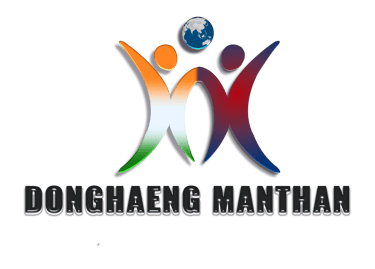The India-South Korea Economic Synergy
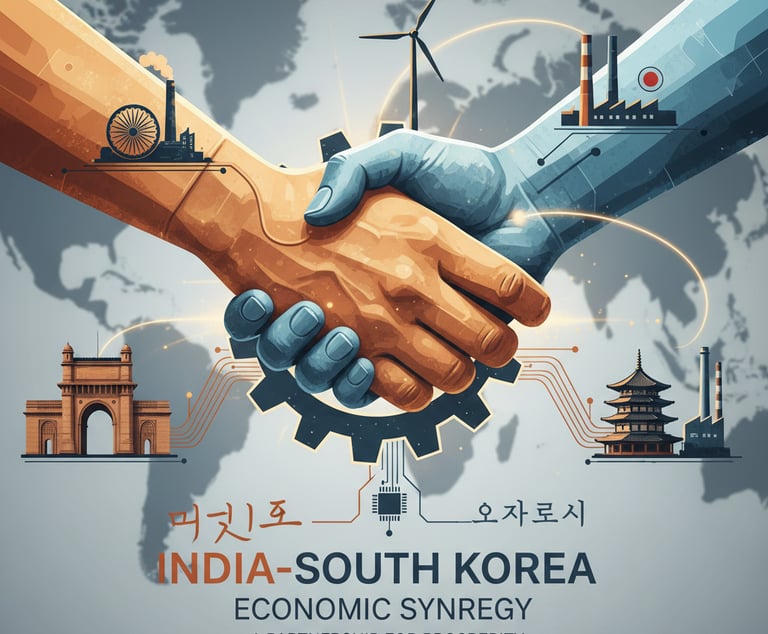

Introduction: Forging a New Era of Asian Leadership
India and South Korea stand as two of Asia's most dynamic economies, each forged through a unique journey of resilience, creativity, and an unyielding commitment to progress. From South Korea’s "Miracle on the Han River," which transformed a war-torn nation into a global industrial powerhouse, to "India’s Digital Revolution," which established the country as a hub for technology and innovation, their parallel stories of growth provide a powerful foundation for a shared future.
The core objective of this report is to analyze the complementary strengths of their leading brands and industries, building a compelling case for future economic partnerships. This analysis moves beyond surface-level trade to explore the deep-seated synergies in technology, manufacturing, sustainability, and culture. We will use the "Donghaeng-Manthan" initiative as the conceptual framework for this collaboration—a vision rooted in the Korean word for "walking together" (Donghaeng) and the Sanskrit word for "deep contemplation" (Manthan). It represents a shared path toward innovation, harmony, and sustainable prosperity.
This report will begin by deconstructing the foundational economic models of both nations. It will then proceed to a sector-specific analysis of collaborative opportunities, explore the critical role of culture and human capital, and conclude with a synthesized vision for a powerful Indo-Korean partnership.
To identify true synergistic opportunities, it is essential to first understand the unique economic architecture that drives growth in both South Korea and India. While both nations have achieved remarkable success, their models are distinct and complementary. This section will deconstruct the core drivers of their economies, establishing a baseline for the high-value partnerships that lie ahead.
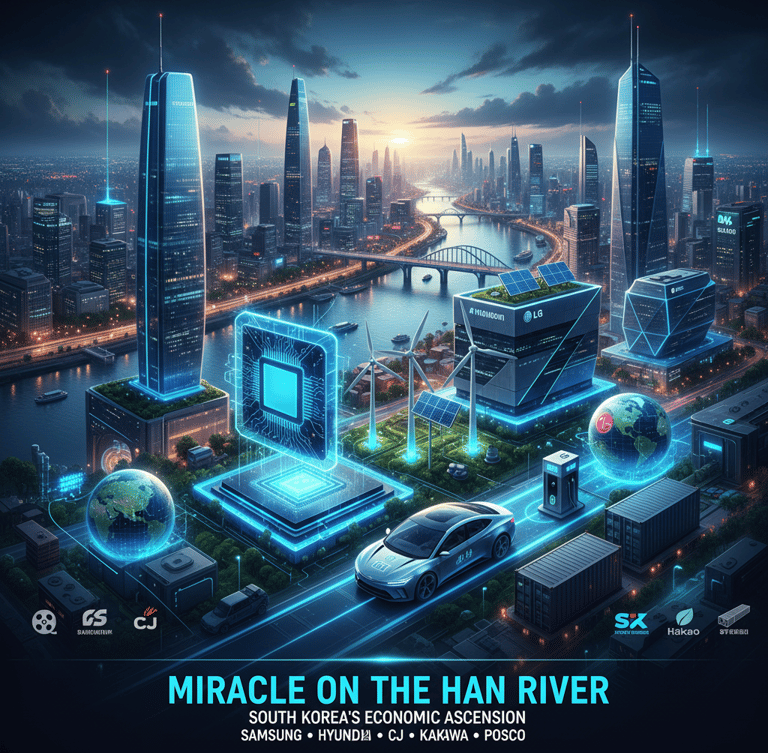

South Korea's economic growth has been primarily powered by its export-driven model, orchestrated by large, family-owned conglomerates known as Chaebols. These industrial giants have not only built the nation's reputation for quality and innovation but also serve as its primary economic engine.
Samsung Group: As the nation's largest conglomerate, Samsung is a global leader in electronics and semiconductors, single-handedly contributing nearly 20% of South Korea's GDP and driving its dominance in memory chips, smartphones, and displays.
Hyundai Motor Group: A top-five global automaker, Hyundai, along with Kia, transformed South Korea into an automotive hub. Today, it is a pioneer in electric vehicles (EVs) and hydrogen mobility, competing directly with established giants in Japan and Germany.
LG Group: A pioneer in consumer electronics and home appliances, LG has become a major global investor in green technology and is a world leader in EV batteries and energy solutions.
SK Group: A dominant force in energy and telecommunications, SK Group is also a critical player in the global technology supply chain through SK Hynix, the world's second-largest memory chip producer.
This economic model, which blends these industrial titans with cultural powerhouses like CJ Group and Kakao, and green technology leaders such as Hanwha and POSCO, embodies the spirit of the "Miracle on the Han River." It is a testament to a national strategy where vision, discipline, and relentless innovation turned a developing nation into a global economic powerhouse.

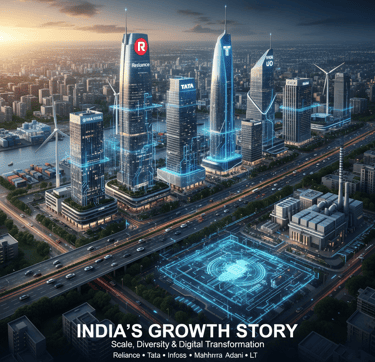
India's economic story is one of scale, diversity, and a strategic pivot toward a knowledge-based economy. Its growth is fueled by a combination of legacy conglomerates and new-age digital pioneers, all contributing to its rise as a global hub for technology, manufacturing, and innovation.
Reliance Industries: India’s largest private enterprise, Reliance has been instrumental in modernizing the nation's industrial and digital landscapes through its vast interests in energy, retail, and, most notably, telecommunications with its Jio platform.
Tata Group: A 150-year-old conglomerate, Tata exemplifies a unique blend of integrity, innovation, and social responsibility across sectors including steel, automobiles (Tata Motors), and information technology (Tata Consultancy Services).
Infosys & Wipro: These firms were the pioneers of India’s IT revolution, transforming the country into a global technology and innovation hub. They symbolize the nation's strength in IT services, consulting, and digital transformation for clients across more than 50 countries.
Mahindra Group: Known for its innovation in automobiles, agriculture, and renewable energy, Mahindra promotes inclusive growth under its "Rise for Good" philosophy, exemplifying India's strength in sustainable, people-centered progress.
Adani Group & Larsen & Toubro (L&T): As powerhouses in infrastructure, energy, and logistics, these groups are at the forefront of national development. Adani Group, in particular, contributes significantly to India’s vision of Atmanirbhar Bharat (self-reliant India) through its massive industrial and green investments.
It is precisely at the intersection of South Korea's high-tech, export-oriented Chaebol structure and India's continent-sized, digitally-driven market that a new blueprint for Asian leadership emerges.
India: Scale, Digital Transformation, and a Rising Global Hub
South Korea: Precision, Technology, and the "Miracle on the Han River"
The Foundations of Two Economic Powerhouses
Moving beyond broad economic profiles, this section provides a deep-dive analysis into specific sectors where the complementary strengths of India and South Korea create tangible opportunities for high-value partnerships. This blueprint highlights the natural alignment between Korean technological precision and Indian scale and software prowess, forming a core pillar of the Donghaeng-Manthan vision.
Sector-Specific Analysis:
A Blueprint for Collaboration
Technology and Semiconductors: Bridging Hardware and Software
The technology sectors of both nations present a symbiotic opportunity. South Korea is an undisputed global powerhouse in hardware and advanced manufacturing. Samsung Electronics and SK Hynix dominate the global supply of DRAM and NAND flash memory, respectively. This industrial might is supported by a robust ecosystem of world-class equipment and materials suppliers, including Hanmi Semiconductor and Wonik IPS, who provide the foundational tools for precision fabrication.
This hardware dominance is perfectly complemented by India's established leadership in IT services, software development, and digital transformation. Firms like Infosys and Wipro have built a global reputation for managing complex digital ecosystems, backed by a vast and growing talent pool of software engineers and designers. The opportunity lies in creating a resilient, vertically integrated supply chain: coupling South Korea's world-leading fabrication foundries with India's burgeoning fabless design ecosystem and its immense pool of software talent.
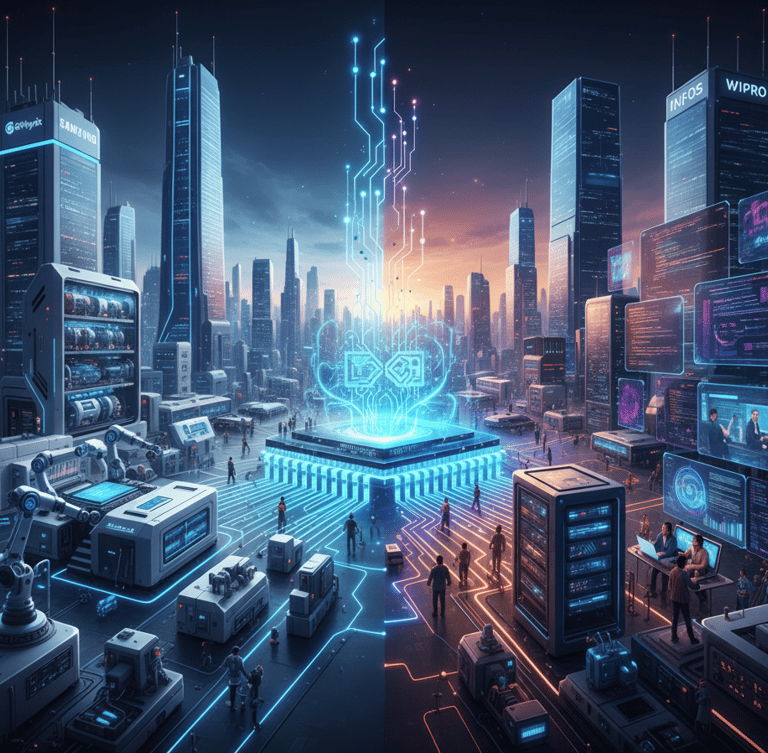

Advanced Manufacturing: From Automotive to Shipbuilding
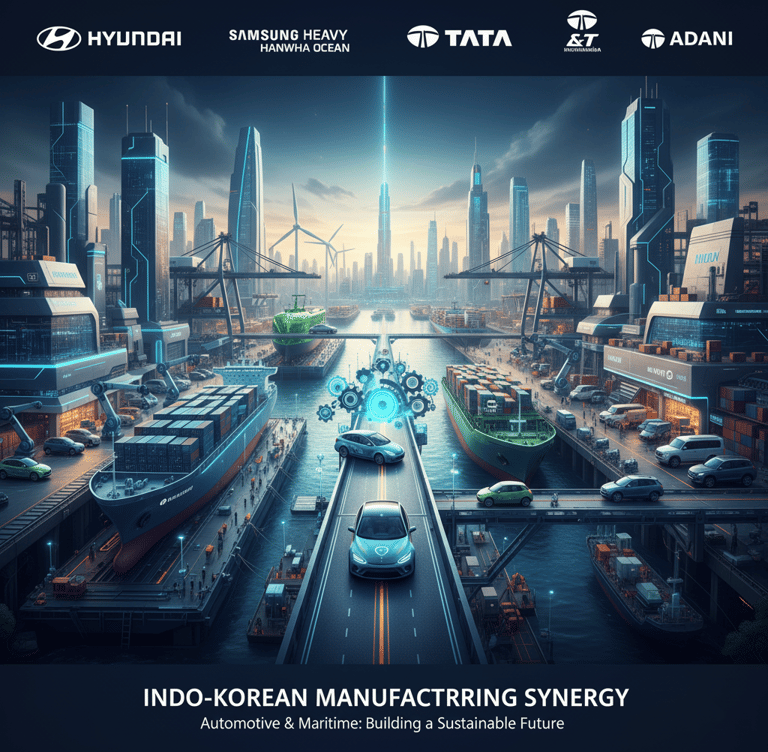

The synergy in advanced manufacturing is equally compelling. In the automotive sector, Hyundai Motor Group is a leader in EV and hydrogen mobility innovation. This focus on next-generation technology aligns with the sustainable and inclusive growth philosophies of India's Mahindra Group and Tata Group, creating opportunities for collaboration in green mobility solutions for a large and diverse market.
In maritime collaboration, South Korea’s global dominance in shipbuilding—led by giants Hyundai Heavy Industries, Samsung Heavy Industries, and Hanwha Ocean—offers another key opportunity. These firms are pioneers in constructing eco-friendly vessels, LNG carriers, and smart ships integrated with AI and IoT. This world-class engineering expertise directly complements India’s expanding port infrastructure and global trade vision, which are being driven by industrial powerhouses like Larsen & Toubro (L&T) and Adani Group.
Green Energy and Sustainability: Powering a Carbon-Neutral Future
South Korea is actively pursuing its 2050 Carbon Neutrality Goal, driven by private and public champions who are global leaders in renewable technology. This creates a powerful platform for partnership with Indian conglomerates making significant green investments.
South Korean Green Energy Leader Core Competency
Hanwha Qcells World-leading solar panel manufacturing and smart energy solutions.
LG Energy Solution Global leader in EV batteries and energy storage systems.
Doosan Enerbility Major player in offshore wind turbine manufacturing and hydrogen production.
POSCO Holdings Pioneer in green steel production using hydrogen-based methods.
These technological advancements in solar, batteries, wind, and green steel align seamlessly with the ambitious green investment initiatives of Indian conglomerates such as Reliance, Adani Group, and Mahindra Group. This symbiotic value chain, combining Korean technology and Indian scale, can accelerate sustainable development across Asia.
The potential for collaboration across these key sectors demonstrates a powerful industrial logic. However, the true depth of this partnership also lies in the complementary nature of their cultural and human capital.
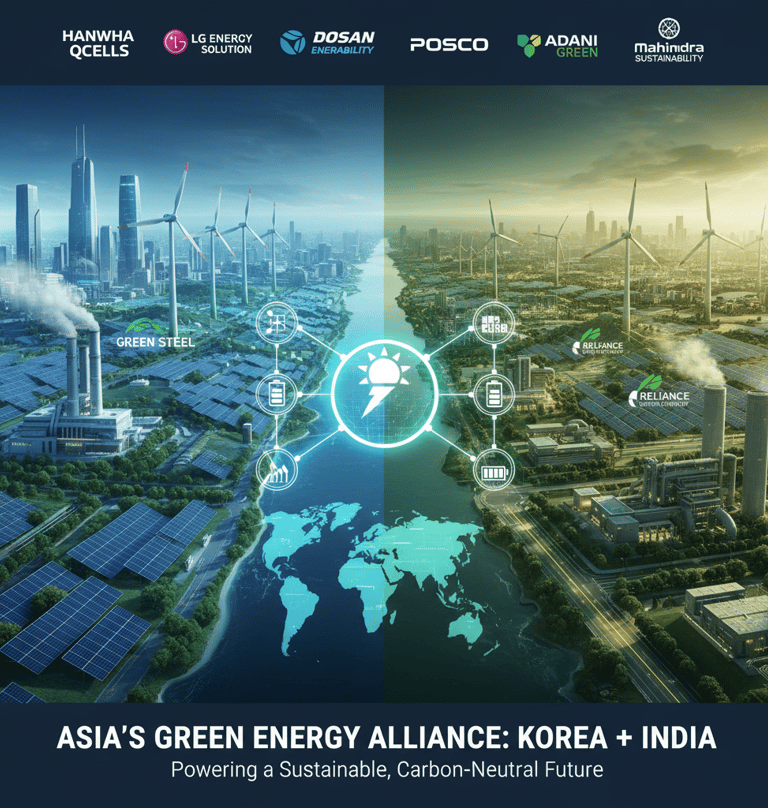

The Power of Culture and Human Capital
Sustainable economic partnerships are built not just on industrial assets and capital but on the foundational elements of people, culture, and shared values. An analysis of the "soft power" and demographic landscapes of India and South Korea reveals another profound and strategic area for collaboration, one that leverages cultural influence and addresses long-term societal needs.
Cultural Industries: The Synergy of Hallyu and Holistic Wellness
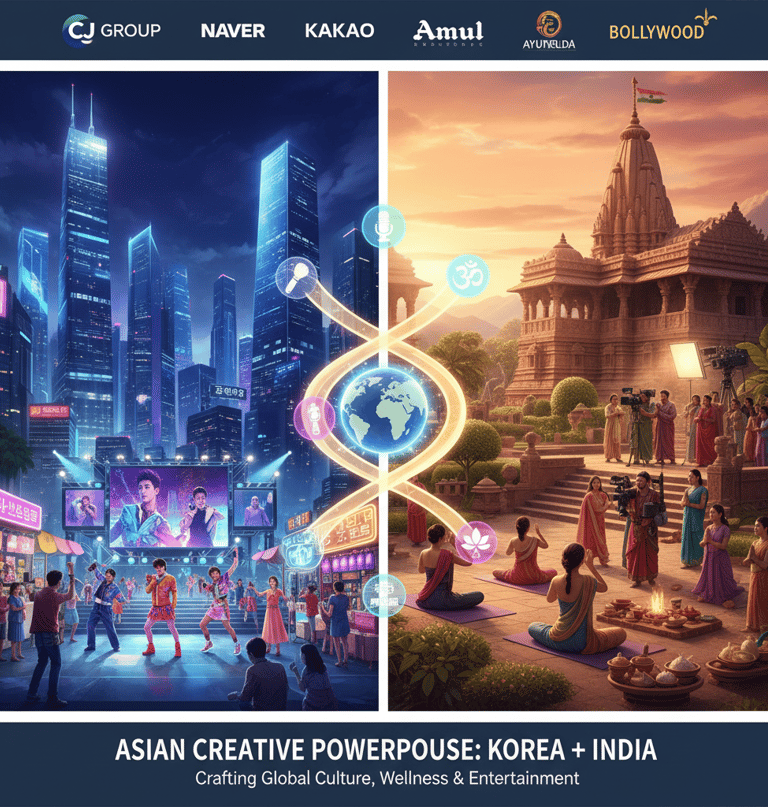

South Korea's global cultural influence, known as the "Korean Wave" or Hallyu, is a formidable economic and diplomatic asset. This phenomenon is driven by a sophisticated ecosystem of industry leaders:
Entertainment: CJ Group has been a primary force behind the global success of K-pop and Korean cinema.
Digital Content: Naver and Kakao have built digital ecosystems that export Korean webtoons, games, and mobile applications worldwide.
K-Beauty: Giants like Amorepacific and LG Household & Health Care have redefined the global skincare market, establishing K-beauty as a benchmark for innovation, quality, and sophisticated branding.
A strategic partnership could combine Korea's proven expertise in R&D, global branding, and distribution with India’s rich heritage of holistic wellness and its own vast and vibrant entertainment industry. This fusion could create new global product lines, entertainment formats, and wellness services that draw from the strengths of both cultures.
Demographics and Social Dynamics: A Complementary Future
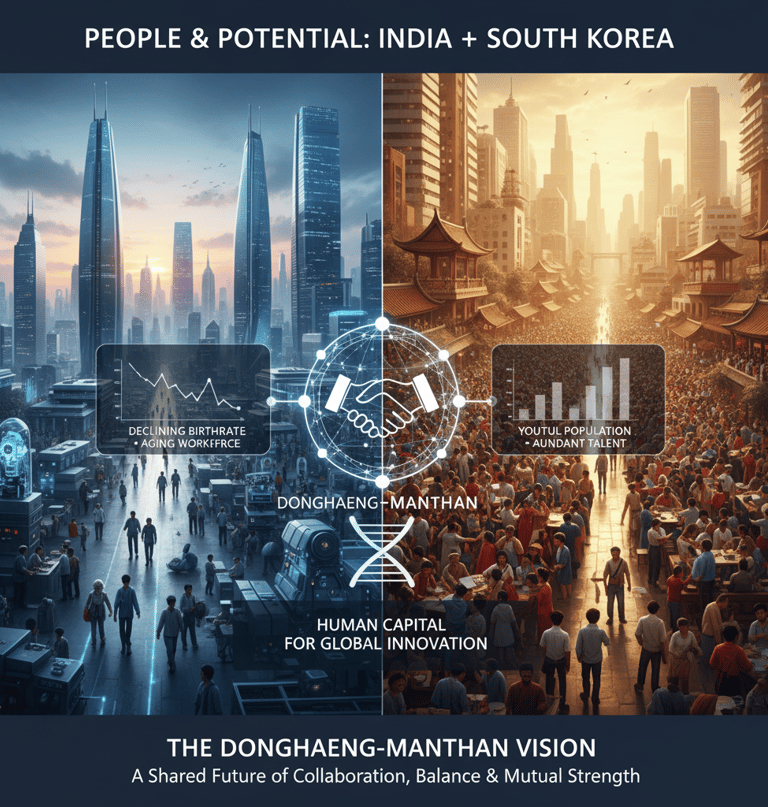

The most critical and complementary aspect of the India-Korea relationship lies in their contrasting demographic profiles. South Korea faces intense societal pressures, including a high-pressure "Hagwan" (cram school) culture, that have contributed to significant long-term challenges. This is most starkly reflected in its birth rate, which at 0.6 is not only lower than Japan's but is the lowest in the world. This demographic crisis poses a severe threat to the nation's future economic vitality and workforce stability.
In stark contrast, India possesses a significant demographic dividend. Its population is characterized by a large, young, and growing talent pool, eager to participate in the global knowledge economy. This demographic symbiosis is not merely a commercial opportunity; it is a strategic imperative that can secure South Korea's future industrial capacity while simultaneously harnessing India's human capital to fuel shared growth.
This synergy in human capital is foundational to the Donghaeng-Manthan framework, but realizing these partnerships requires a clear and actionable path forward.
Conclusion: A Shared Vision for Asian Prosperity

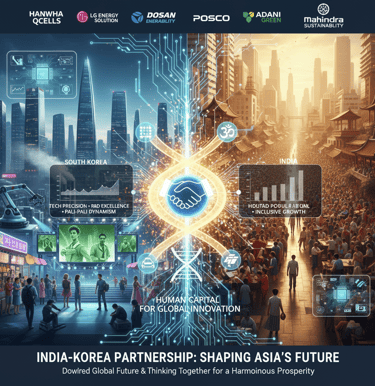
This report has detailed the profound and complementary relationship between India and South Korea. The strategic alignment of South Korea's technological precision, advanced manufacturing capabilities, and R&D leadership with India's market scale, digital innovation, and vast human capital creates an unparalleled partnership opportunity. From semiconductors and green energy to cultural industries and human resources, the synergies are clear, tangible, and poised to generate immense value.
To succeed, this partnership must move beyond surface-level trade and navigate complex cultural dynamics, translating South Korea's hierarchical and rapid decision-making ('pali-pali') culture and India's consensus-driven, emergent approach into a new, hybrid operational model built on genuine trust.
By embracing the "Donghaeng-Manthan" vision of walking and thinking together, the India-Korea partnership can become a beacon of cooperation in the 21st century. Together, these two nations are positioned not just to shape markets or drive economic growth, but to define the very future of sustainable, innovative, and harmonious prosperity in Asia and beyond.
Connect
Join us in sustainable innovation efforts.
Engage
Support
© Donghaeng-manthan 2025. All rights reserved.
